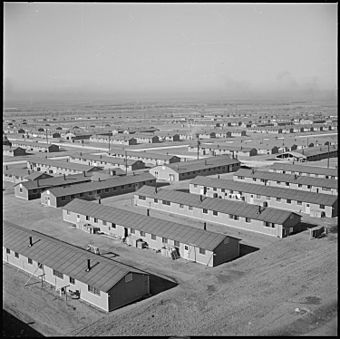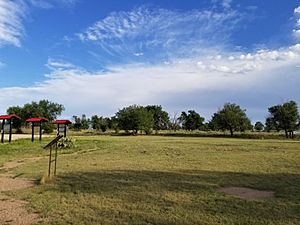Granada War Relocation Center facts for kids
|
Granada Relocation Center
|
|

A general view of a section of the site looking north and west.
|
|
| Location | 23900 County Road FF, Granada, Colorado |
|---|---|
| Built | 1942 |
| Architect | US Army Corps of Engineers; Lambie, Moss, Litle, and James |
| NRHP reference No. | 94000425 |
Quick facts for kids Significant dates |
|
| Added to NRHP | May 18, 1994 |
| Designated NHL | February 10, 2006 |
The Granada War Relocation Center, also known as Camp Amache, was a special camp built in southeast Colorado. It was about a mile west of the small town of Granada. During World War II, this camp was used to hold Japanese Americans. It was one of ten such camps in the United States.
Camp Amache was added to the National Register of Historic Places in 1994. It was later named a National Historic Landmark in 2006. This means it is a very important historical site.
Contents
History of Camp Amache
Why the Camp Was Built
After Japan attacked Pearl Harbor on December 7, 1941, the United States entered World War II. President Franklin D. Roosevelt then signed something called Executive Order 9066. This order forced Japanese Americans living on the West Coast to leave their homes. About 120,000 Japanese Americans were moved from their homes. They first went to temporary "assembly centers." Later, they were sent to more permanent and isolated "relocation centers" like Granada.
The government agency in charge of these camps was the War Relocation Authority. Granada was the only camp built on land that was privately owned. The camp covered about 10,000 acres (40 square kilometers). Only 640 acres (2.6 square kilometers) were used for buildings. The rest of the land was used for farming. Most landowners did not want to sell their land. The government had to take it using a process called condemnation.
However, the governor of Colorado, Ralph Lawrence Carr, was different. He was one of the few leaders who welcomed Japanese Americans. He did not oppose a camp being built in his state. This was unusual because many people at the time had strong anti-Japanese feelings.
Life at the Camp
Granada opened on August 27, 1942. By February 1943, it held 7,318 people. This made it the smallest of the ten camps. However, over 10,000 people passed through the camp during its three years. Most people came from California, especially from Los Angeles and the Central Valley. Many were from the Yamato Colony, a farming community. People were only allowed to bring one bag. This meant they had to sell or give away most of their belongings.
The camp quickly became known as Camp Amache. It was named after Amache Prowers, a daughter of a Cheyenne chief. She was married to John Wesley Prowers. The county where the camp is located is named after him.
The living area of Camp Amache was on a low hill. This helped prevent floods and mud. But the area often had strong winds and dust storms. The camp was surrounded by barbed-wire fences. There were also eight machine-gun towers. However, these towers were rarely used. The camp director, James G. Lindley, allowed people to take day trips to Granada. Some local people were not friendly at first. But many businesses eventually hired Japanese Americans. They also started selling things that Amache residents wanted.
Education and Activities
In 1943, there were protests about building Amache High School. People in Colorado were still recovering from the Great Depression. They felt their tax money should not support Japanese American students. Some even said the government was "pampering" the enemy. The high school was finished in June 1943. Plans for separate elementary and junior high schools were stopped. Younger students shared the high school building or had classes in barracks.
The high school football team was very good. They lost only one game in three years. One special game was against the undefeated team from Holly, Colorado. Holly agreed to play at Amache's home field. The Amache team won 7-0. This meant the Amache team was undefeated on their own field.
Adults at the camp had different jobs. The camp had its own police and fire departments. Japanese American internees worked in these departments. Some people who were teachers before the war taught in the camp schools. A silkscreen shop was also set up. Its workers made training materials and posters for the U.S. Navy. They also made calendars and other items for camp residents. Doctors, nurses, and dentists worked at the camp hospital. They were paid much less than white workers. Sometimes, other internees would collect money to help them.
Most of the work at Granada was farming. The land around the living areas was used to grow crops and raise animals. The camp was supposed to produce most of its own food. This helped save money and avoid complaints. The farmers at Granada were very successful. They grew enough food for the whole camp. They even sent extra food to the U.S. Army and other camps. For example, in 1943, they grew 4 million pounds of vegetables.
Japanese American leaders also started a special Amache District for Boy Scouts. These Scouts still flew the American flag. This showed their loyalty, even though they and their families were held in the camp.
Military Service
Many Japanese Americans from the camps joined the U.S. Army. In 1942, the 100th Infantry Battalion was formed. It was made of Japanese American soldiers from Hawaii. Later, the 442nd Regimental Combat Team was created. About 1,500 men from the mainland camps, including Amache, joined. These units became very famous for their bravery. They were known as the "Purple Heart Battalion" and for their motto "Go For Broke." They became the most decorated unit in the war. From Camp Amache, 441 Japanese Americans joined the U.S. Army.
In the southwest part of the camp, there is a small cemetery and a memorial. The memorial honors the Japanese Americans from Amache who fought in World War II. The graves in the cemetery are for children who died while living at the camp.
Camp Amache Today
Today, Camp Amache is a quiet, empty place. Most of the original buildings were removed. They were sold at auction and moved away. Only one original building remains, a pumphouse. The concrete foundations of most buildings are still there. The land was sold after the war. Signs have been put up to show where the schools, laundries, and dining halls once stood. Highway signs now identify the site as Camp Amache.
Since 1990, students from Granada High School have worked to preserve the site. Their group is called the Amache Preservation Society. As a school project, they have also set up a museum for the Granada War Relocation Center.
In 2006, President George W. Bush signed a law. This law provided $38 million to help restore Amache and nine other former Japanese American internment camps.
Notable People from Camp Amache
Many people who lived at Camp Amache later became famous. Here are a few:
- Kaneji Domoto (1913–2002), an architect and landscape designer.
- Mike Honda (born 1941), an American politician.
- Lawson Fusao Inada (born 1938), an American poet.
- Yasuhiro Ishimoto (1921–2012), an important photographer.
- Kiyoshi K. Muranaga (1922–1944), a U.S. Army soldier who received the Medal of Honor.
- Yuriko Nakai (born 1932), an American watercolor artist and writer.
- Sab Shimono (born 1937), an actor.
- Pat Suzuki (born 1930), a popular singer and actress.
- Edison Uno (1929–1976), a Japanese American civil rights activist.
In Media
- Author Sandra Dallas wrote a book called Tallgrass. It uses Granada as the setting for its story.
- Lily Yuriko Nakai Havey, who lived at Amache, wrote a book about her time there. It is called "Gasa Gasa Girl Goes to Camp" and was published in 2014.






